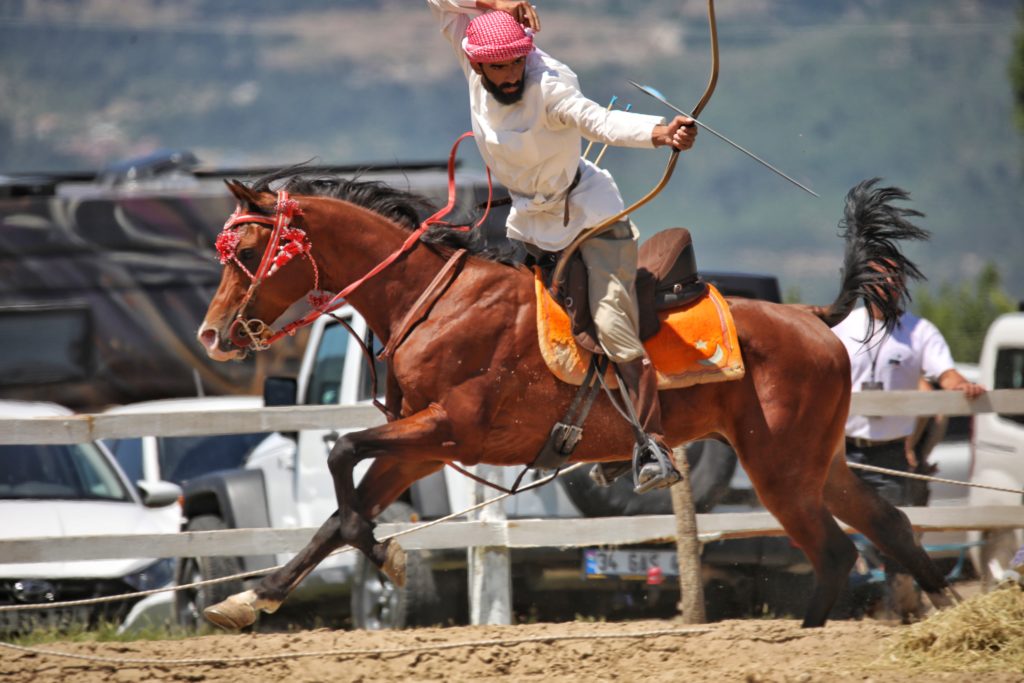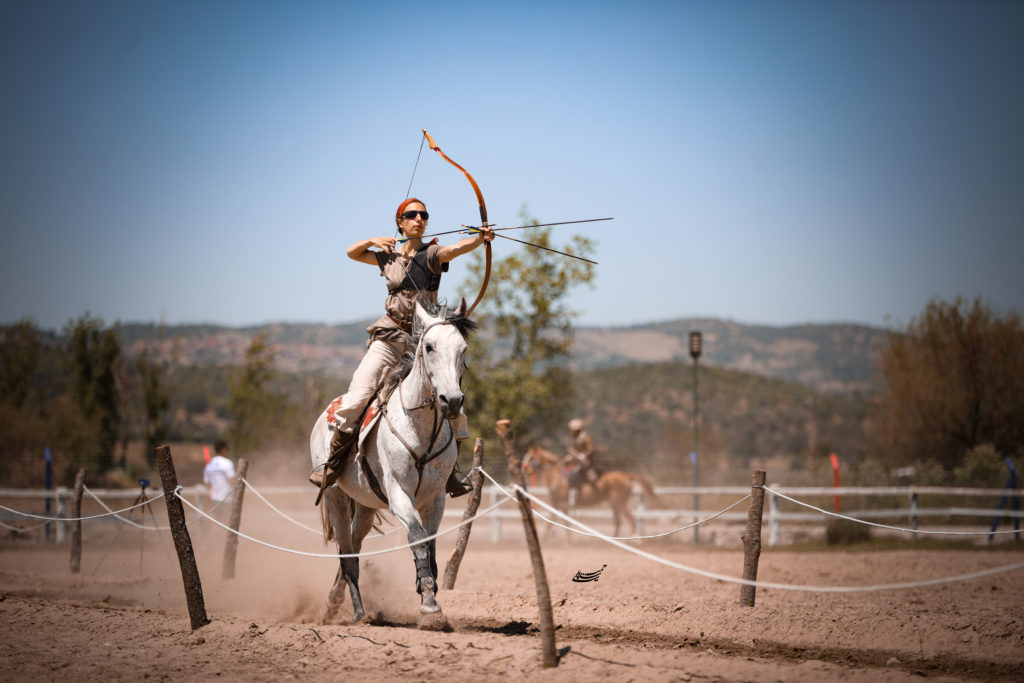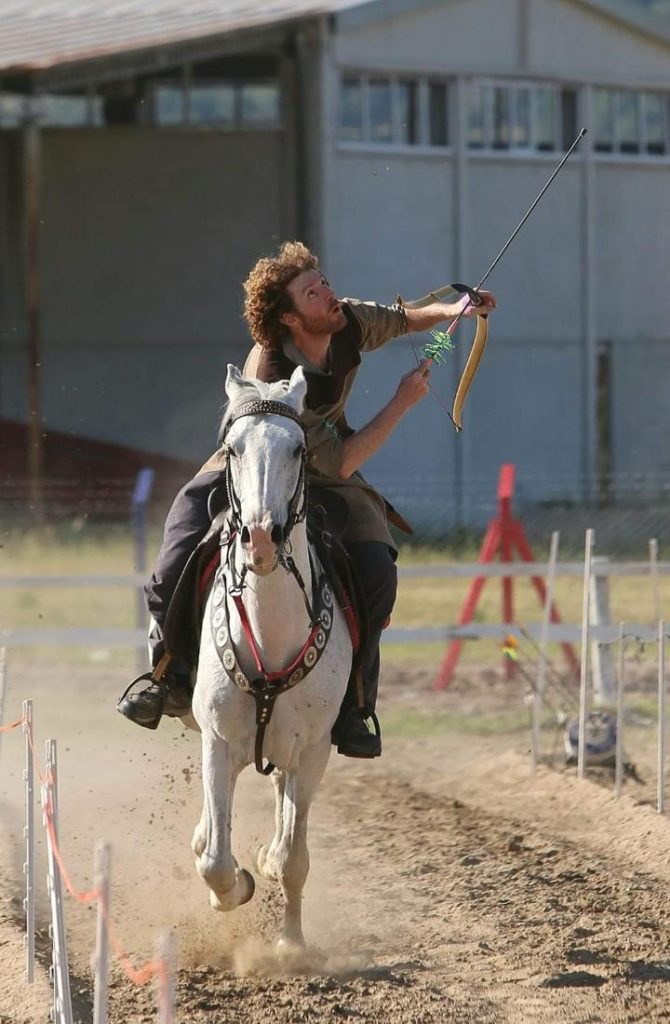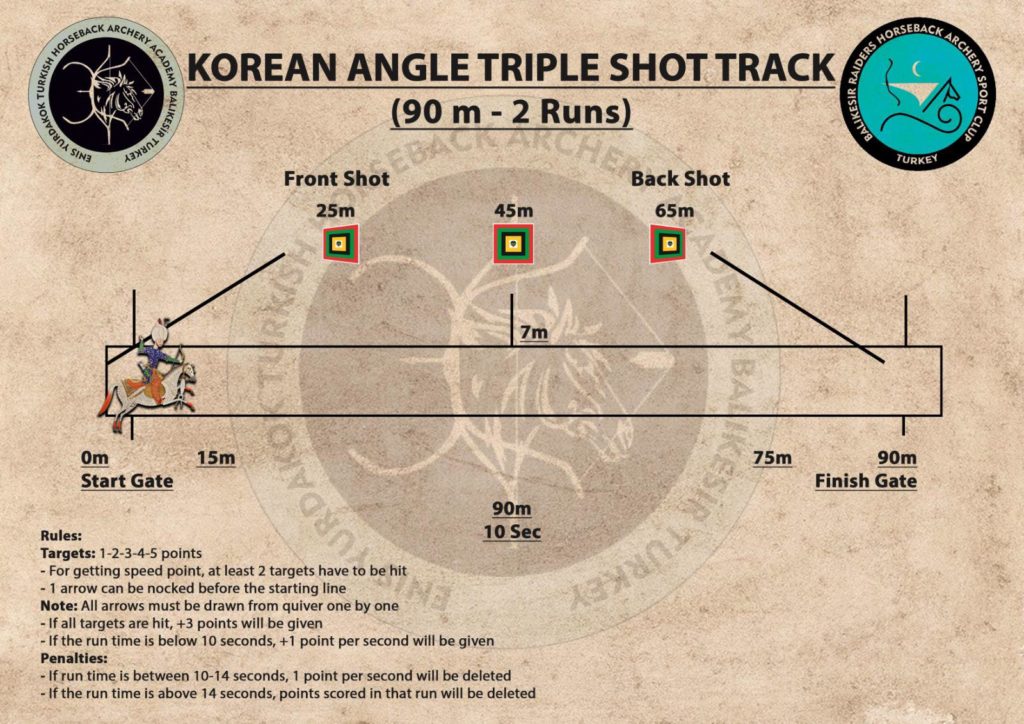Anne Dohrmann got back in the saddle at Akinci Toyu 2022 – with mixed results
After a long lull in the international tournament scene of mounted archery, a private organiser invited people to a small town in Turkey with some big promises. Akinci Toyu was to be the biggest mounted archery tournament in the world – a superlative, demanding event, with full TV and media coverage.
The organiser Enis Yurdakök painted a promising vision of his tournament in Sindirgi, a small town near Balikesir, about 200km south of Istanbul. Originally planned for spring 2020, the actual date was postponed by two years until May 2022 due to the pandemic.
There were detailed digital plans for a specially built, professional arena and presentations of new competition disciplines. In the end, 74 male and female athletes from 29 nations registered – a remarkable number.
After two years without international tournaments, I was more than excited to finally be able to travel again for my sport. I’d heard tales from my friends about the particularly spirited and fast Turkish thoroughbred horses. My imagination was running riot.
Two weeks later, after a turbulent journey with many ups and downs, I returned with my luggage full of memories and impressions. It turns out my vivid imagination would be tempered with a serious dose of reality.
The organisation
The foundation of every tournament is a solid organisation. Anyone who has organised a competition knows the effort and time that goes into it. Organising horses for 74 riders and managing the logistics for international participants are just two of the many tasks facing the organising team.
As usual, bus transfers were arranged from the airport to the competition venue. However, information was very sparse, so the exact departure time of the bus remained uncertain and in the end there were waiting times for some athletes of up to seven hours before the long journey even started. Participants who had rented a car on their own fared much better.
The venue itself, a large equestrian arena with spectator stands and massive yurts for permanent use, was built specifically for Akinci Toyu. We were accommodated in a hotel in the mountains not far from Sindirgi. The location was wonderful, there was even a pool, but unfortunately the number of rooms were not enough for the number of participants, so the rooms often had to be double occupied. Many bathrooms were mouldy, and the food was unexceptional – Turkish cuisine is known for better quality. The schedule also changed without warning.
A key part of planning is providing a sufficient number of loan horses for all archers. Normally, this point is clarified before the tournament is even advertised, as the total possible participants ultimately depends on the horses. This principle was unfortunately not followed here, so that there was a significant shortage of horses. Needless to say, this caused issues throughout the entire tournament.
The opening ceremony
The competition lasted four days with a total of four different disciplines, starting with an extensive opening ceremony. After breakfast, the female archers retired to put on their competition robes. We were explicitly asked by the organiser to wear historical or traditional clothing, which is more or less authentic depending on the nation.
Soon we were standing together, a hodgepodge of nations, admiring each other’s costumes. It was a very special atmosphere of exoticism, appreciation and friendship. After obligatory group pictures in every imaginable combination, we squeezed into minibuses and bumped down to the town of Sindirgi.
The exact course of the ceremony is not really clear to anyone – what is clear is that there are not enough horses. Hoping to get hold of one, I quickly set off with my close circle of friends to the stables. It turned out whoever sits on one first gets to keep it. When I finally understand this ‘system’, I grab one of the last animals, a lean chestnut with a spark of madness in his eyes.
My teammate quickly hands me the big German flag, and then we’re off. While the horseless athletes are brought back to the starting point by bus, the procession of riders jogs at a brisk trot over gravel field paths from the stables at the somewhat out-of-town competition venue to the city. Families wave kindly at us from the houses at the side of the road. Fortunately, the huge free-roaming Anatolian herding dogs only stare at us. The street is packed with young people, horses, flags and cars.
I am impressed by the nerve of my little stallion, who stoically takes the situation in his stride. Two other horses are not so calm and cause a brief, explosive brawl in the street, creating a small commotion and briefly breaking up the crowd. But the dispute is quickly settled and soon visitors are crowding around the animals again.
Then the procession starts. A pickup truck with loudspeakers and a film crew on the back, which broadcasts the procession live on television, drives up to the front. A presenter proclaims fervent messages in Turkish that seem to repeat themselves every five minutes. The music selection consists of three songs played on a continuous loop.
As far from patriotism as I usually am, I cannot deny the joy and pride I feel as I carry my flag through the city on horseback. What makes me most happy are the many girls and women who wave to me and are very happy about me waving back.
The tournament
The prospect of success at a competition like this stands and falls with a good horse. It turned out 25 mounts were available for the 74 starters. Normally, one calculates with two riders per horse at tournaments, three riders are an exception and are only allowed by the judge with really well trained animals. Here it is the rule.
For this reason, the number of runs is halved from six to three on the evening before the first discipline. This makes the results less comparable, and the influence of chance increases. In Germany and at most IHAA tournaments, this is why they ride the Hungarian Tower Track nine times, for example, in order to weight a consistent performance accordingly.
My teammate and I are lucky enough to ride the horse of a Turkish friend. The stallion Karaduman is a strikingly large grey horse with a black mane and tail and a decidedly calm charisma. His movements are expansive and thus appear relaxed despite the high speed. He is also relaxed in the starting area, a great advantage over nervous animals who test your nerve before they have even put a hoof on the track.
The disciplines were:
The Castle Track: a Turkish interpretation of the Hungarian Tower Track.
The Turkish Tabla: a real challenge with small targets and high speed.
The Raid, angled triple: a classic international discipline.
The Qabaq: rich in tradition with acrobatic elements.
After a trial gallop without shooting, we each had three runs to set our arrows close to the target for the audience. No one in my group is shooting to their ability today. The consolation is that obviously the audience doesn’t really care. I hardly get back to my place on the grandstand after my ride because masses of children ask me for a selfie. I grin into more cameras than I usually do in an entire year, and give an autograph for the first time in my life.
The next discipline, after a change of plans at short notice, was the Turkish Tabla. The diameters of the round targets, 30 and 60cm, are significantly smaller than those of the usual targets. The time limit is also tight – the horse has to run at least 35km/h in order not to lose its rider any points.
The historical essence of mounted archery – accuracy at high speed – is particularly well captured in the Tabla Track. I enjoyed this discipline a lot, because precision is really required here. My shooting performance was even respectable after the flop in the Castle Track.
The last two disciplines were done together: two runs of Qabaq, directly followed by two runs of Raid (angled triple). The Qabaq is the oldest surviving discipline of mounted archery. Historically, the target was a gourd at a height of at least 9m on a pole.
Today, one shoots at a round metal target that acknowledges a hit with a loud clang. Ideally, for this shot one should bend low on the left side of the horse’s neck and rotate the upper part of the body through 90 degrees in order to be able to shoot vertically upwards after the horse has just passed the pole. Only a few shooters can pull off this acrobatic feat.
The main judge of the competition was Koray Demirkan, an official judge from the Traditional Equestrian Sports Association. Although the target judges also had the appropriate qualifications, there was already unrest and objections regarding the scoring during the competition.
At times, one could observe how the target judges indicated a zero score in case of a clear hit on the target. I have never experienced such obviously questionable judging at a tournament.
The horses, and other issues
Like most of the other competitors, I was shocked by the way the horses were treated, as their welfare is usually a top priority at other competitions. Of course, the stables are not always perfect and often provisional, especially at big events, but in Akinci Toyu the level of horse care was unfortunately strikingly low.
Even Turkish friends who were not involved in the show planning themselves expressed their regret about the organisation and horse treatment to the international guests. In a conversation with the organiser Enis Yurdakök, he admitted the less than ideal situation and assured that there would be renovated and better stables in the new year.
The results of the Tabla competition caused a big uproar on the evening before the last day of the competition. Many participants questioned their accuracy. After a dispute with the organiser, ten athletes decided against further participation in the tournament.
A continuation of this discussion followed the next day. In the middle of the Qabaq, the Mongolian archers confronted the judge and his team. Using their own video footage from the previous day, they demanded a correction of the results.
After a 40-minute debate, the Mongolians finally settled down demonstratively on the competition track and blocked the event. The situation resolved itself in an apology from the organiser and the presentation of first and third place Tabla medals to the Mongols. What justification this questionable interlude had remained uncertain to me.
The overall winners were finally honoured in two categories: male and female. Normally, no distinction is made between the sexes in mounted archery.
Winners (male, as well as mixed):
1st: Bünyamin Baysal (Turkey)
2nd: Abdullah Yilmaz (Turkey)
3rd: Davut Cakir (Turkey)
Winners: (Female)
1st: Anne Dohrmann (Germany)
2nd: Nina Yankova (Bulgaria)
3rd: Camilla Linderberg (Sweden)
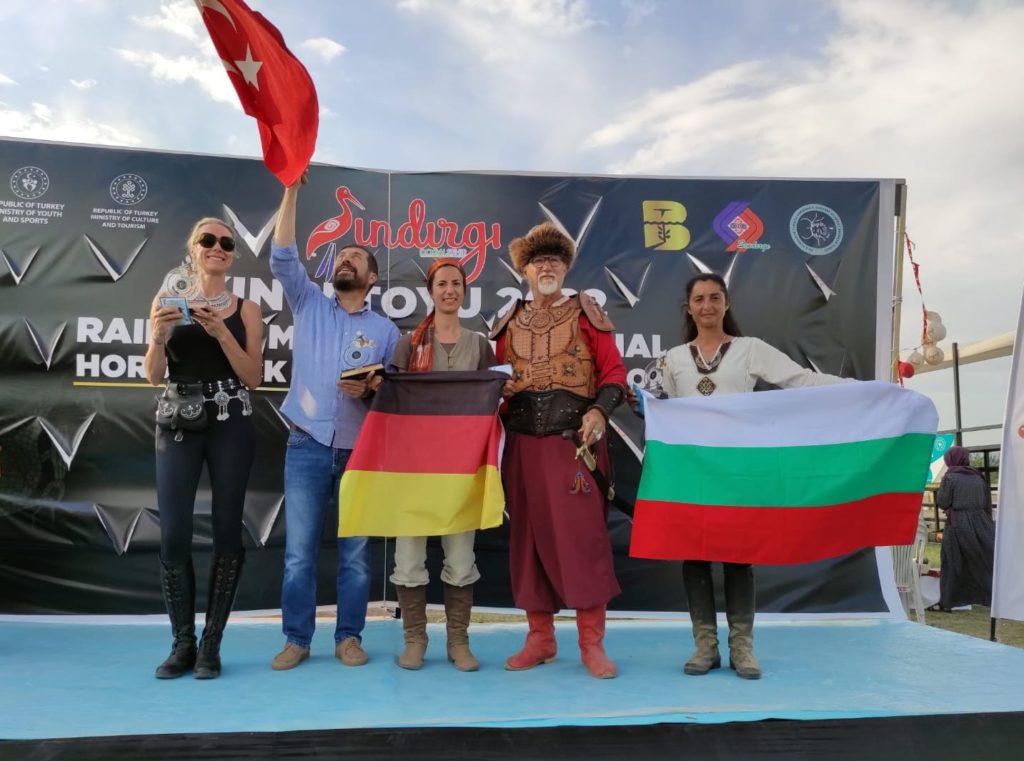
The male winners were richly honoured with many material prizes, bows, boots, quivers and also cash prizes (1500, 1000, 500 dollars). The women received a cup and a small bag of dumplings each. A somewhat fairer distribution of prizes would have been easy to implement, in my opinion, and a pure question of decency.
In retrospect, I remember Akinci Toyu with mixed feelings. I am grateful for the opportunity to meet my friends from all over the globe again in Turkey, and for my fine horse Karaduman. Unfortunately, there were also many aspects of the show that could and should have been better.


